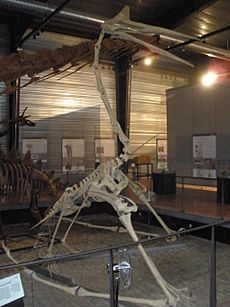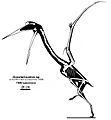Quetzalcoatlus facts for kids
Quick facts for kids QuetzalcoatlusTemporal range: Upper Cretaceous
|
|
|---|---|
| Senckenberg Museum, Frankfurt | |
| Scientific classification | |
| Kingdom: | |
| Class: | |
| Order: | |
| Suborder: | |
| Family: |
Azhdarchidae
|
| Genus: |
Quetzalcoatlus
Lawson, 1975
|
Quetzalcoatlus was an amazing flying reptile called a pterosaur. It was the biggest animal known to have ever flown! Imagine a creature with wings as wide as a small airplane, about 10 to 12 meters (33 to 40 feet) from tip to tip. Even though it was so huge, it was quite light, weighing around 200 pounds.
This giant pterosaur had a super long neck. When it stood on the ground, it was as tall as a giraffe! Its fossils have been found in North America, dating back to the Upper Cretaceous period, about 70 to 65.5 million years ago. Quetzalcoatlus disappeared during a big event called the K/T extinction event, which caused many animals, including the dinosaurs, to become extinct.
Contents
How Was Quetzalcoatlus Discovered?
The first Quetzalcoatlus fossil was found by a college student named Douglas Lawson. He was exploring Big Bend National Park in Texas. Douglas saw a bone sticking out of a rock. It looked hollow, just like a bird's bone. This made him think it belonged to a flying creature.
He was right! With help from his professor, Douglas kept digging. They found many bones from an arm and wing. Sadly, the rest of the animal's body was missing. Many people have searched for the missing parts of this huge pterosaur, but they have never been found. Other Quetzalcoatlus fossils have been discovered since then, but none are as big as the one Douglas Lawson found.
Could Quetzalcoatlus Really Fly?
Because Quetzalcoatlus was so big, some scientists wondered if it was too heavy to fly. This would have been very surprising, as no other pterosaur fossils suggest they couldn't fly. It was thought that pterosaurs couldn't move well enough on the ground to survive without flying.
However, after more study, most experts now agree that Quetzalcoatlus probably could fly. Some research even suggests it was a very strong flyer. Since we only have a few bones from this amazing creature, it's still hard to know its exact weight. But the idea that it flew is widely accepted.
What Did Quetzalcoatlus Eat?
Quetzalcoatlus had a long beak but no teeth. Scientists are still trying to figure out what it ate and how it found its food. The main problem is that we don't have a complete skeleton to study. Two main ideas have been suggested about its diet.
Did It Eat Fish?
One idea is that Quetzalcoatlus ate fish. It might have flown low over the water with its jaw open, snapping up fish when it touched them. At that time, much of Texas was covered by a large inland sea called the Western Interior Seaway. This idea, called "fish-eating in flight," has been quite popular.
Did It Eat on Land?
The other idea is that Quetzalcoatlus ate on land. It might have been a carrion feeder, meaning it ate dead animals, much like vultures do today. It also might have hunted for small animals on the ground. This idea is becoming more popular. This is because its jaw doesn't look like the jaws of modern birds that catch fish by skimming the water.
When Quetzalcoatlus flew, it likely soared high in the sky. It would have used warm air currents, like modern gliders. Its fossils were found far inland, suggesting it lived in a warm environment away from the coast.
Quetzalcoatlus in Movies
Quetzalcoatlus was featured in the movie When Dinosaurs Roamed America. In the film, it was shown eating the body of a dead Triceratops.
Images for kids
-
A Quetzalcoatlus skeleton displayed in a flying pose at the Royal Ontario Museum.
-
Models of pterosaurs on London's South Bank for an exhibition.
See also
 In Spanish: Quetzalcoatlus para niños
In Spanish: Quetzalcoatlus para niños











